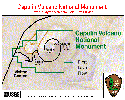
USGS/Cascades Volcano Observatory, Vancouver, Washington
DESCRIPTION:
Capulin Cinder Cone, New Mexico
-
 [Map,73K,InlineGIF]
[Map,73K,InlineGIF]
Map, Capulin Cinder Cone
From:
Wood and Kienle, 1990, Volcanoes of North America: United States and Canada:
Cambridge University Press, 354p.,
Contribution by: David Gust
-
The Raton-Clayton volcanic field, in the extreme northeastern corner of
New Mexico, is
Pliocene to Holocene in age.
Approximately 120 basaltic to nephelinitic
cinder cones,
ranging in age from greater than 1 million to 2,300 years old, are distributed
throughout the field, with a concentration of feldspathoidal compositions near
the town of Des Moines. Many cones have associated lava flows. Perhaps the
most impressive cone is the youngest, which is fortunately protected as
Capulin National Monument.
The rim of this steep-sided cinder cone is
approximately 1.7 kilometers in circumference, and stands 305 meters high, with
a crater depth of 125 meters. A variety of andesitic and dacitic volcanic necks
and domes also occurs throughout the field; Sierra Grande, a large
stratovolcano
15 kilometers in diameter and 600 meters in height, is composed of
numerous flows of a distinctive and homogeneous andesite. ...
Raton is approximately 125 kilometers east of Taos, New Mexico.
U.S. Highway 64 cuts directly through the center of the field and connects the
towns of Raton and Clayton.
From:
U. S. National Park Service,
Capulin Volcano National Monument Website, 1998
-
Capulin Volcano,
a nearly perfectly-shaped
cinder cone,
stands more
than 1,200 feet above the surrounding High Plains of
northeastern New Mexico.
The volcano is long extinct, and today the forested slopes
provide habitat for mule deer, wild turkey, black bear and other
wildlife. Abundant displays of wildflowers bloom on the mountain
each summer. A 2-mile paved road spiraling to the volcano rim makes
Capulin Volcano one of the
most accessible volcanoes
in the world.
Trails leading around the rim and to the bottom of the crater allow a
rare opportunity to easily explore a volcano.
-
Capulin Volcano erupted approximately 60,000 years ago with
firework-like "rooster tails" of glowing hot cinders that flew through
the air. Lava that flowed from vents located at the volcano's flank
covered almost 16 square miles. Although no longer a volcano in
action, Capulin Volcano remains a dramatic testament to the
volcanic processes that shaped northeastern New
Mexico.
Capulin Volcano National Monument
was established
in 1916 to preserve this striking example of a
volcanic cinder cone.
From:
U. S. National Park Service,
Capulin Volcano National Monument Website - Geology Fieldnotes, April 2000
-
Capulin Mountain is the cone of a volcano that was
active only about 62,000 years ago.
This
cinder cone
represents the last stage of a great period of
volcanism that had begun about eight million years earlier.
Evidence of this activity can be seen in the
scores of nearby volcanic hills and peaks.
The largest of these is the Sierra Grande, an extinct volcano
rising some 2,200 feet above the surrounding plain,
about 10 miles to the southeast. To the northwest of
Capulin are a number of mesas that are capped with lava,
the three largest of which are Barella, Raton, and Johnson mesas.
-
In the great volcanic area, called the
Raton-Clayton volcanic field, volcanism occurred in three main
episodes, separated by long periods of inactivity.
Capulin Volcano formed during the last period of
activity. Its conical form rises more than 1,300 feet above
the plains to 8,182 feet above sea level. The
mountain consists chiefly of loose cinders, ash, and other rock debris.
These materials were spewed out
by successive eruptions and fell back upon the vent,
piling up to form the conical mound. ...
-
The eruption began with a northwest-oriented fissure vent
that soon came together to form a single
central vent. This vent sent cinders high into the air;
they piled up around the vent to produce the
Capulin cinder cone.
During this cinder eruption, the first
lava flow oozed through the cinders to flow eastward.
After the gas in the magma was depleted, lava flows then
oozed out of the mouth on the west side of the
cinder cone. These flows flowed at least partly in lava tubes,
from the Boca first to the south (second
lava flow), then southwest (third lava flow), and
finally to the northeast and north (fourth lava flow),
covering more than 25 square miles. ...
Return to:
[Capulin Cinder Cone Menu] ...
[New Mexico Volcanoes and Volcanics Menu] ...

URL for CVO HomePage is:
<http://vulcan.wr.usgs.gov/home.html>
URL for this page is:
<http://vulcan.wr.usgs.gov/Volcanoes/NewMexico/Capulin/description_capulin.html>
If you have questions or comments please contact:
<GS-CVO-WEB@usgs.gov>
01/24/01, Lyn Topinka
 [Map,73K,InlineGIF]
[Map,73K,InlineGIF]

 [Map,73K,InlineGIF]
[Map,73K,InlineGIF]
